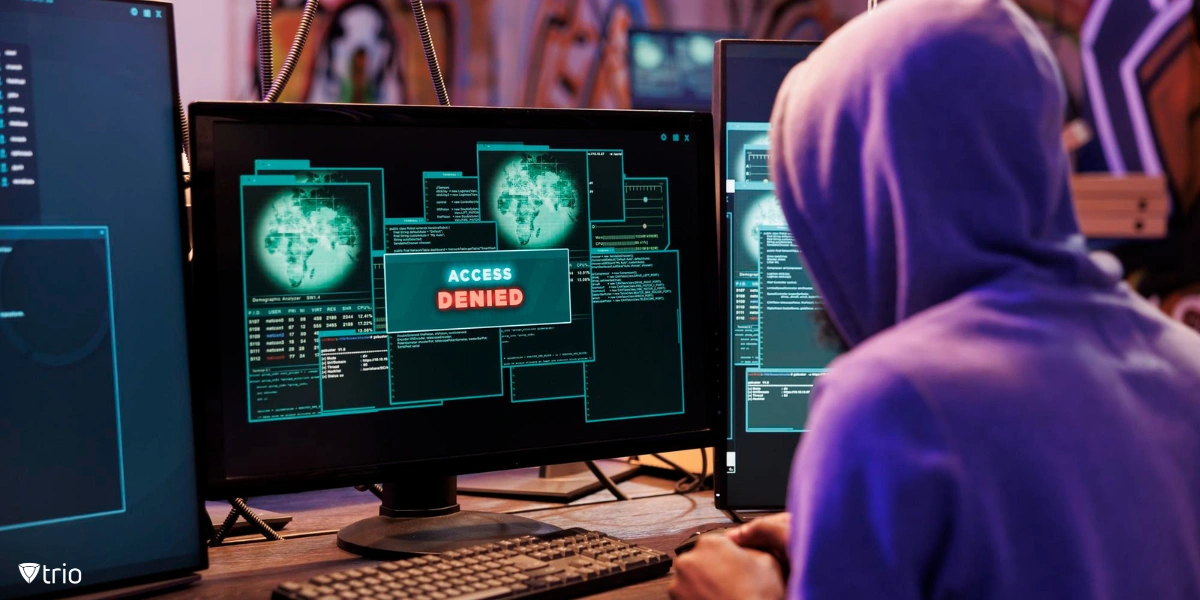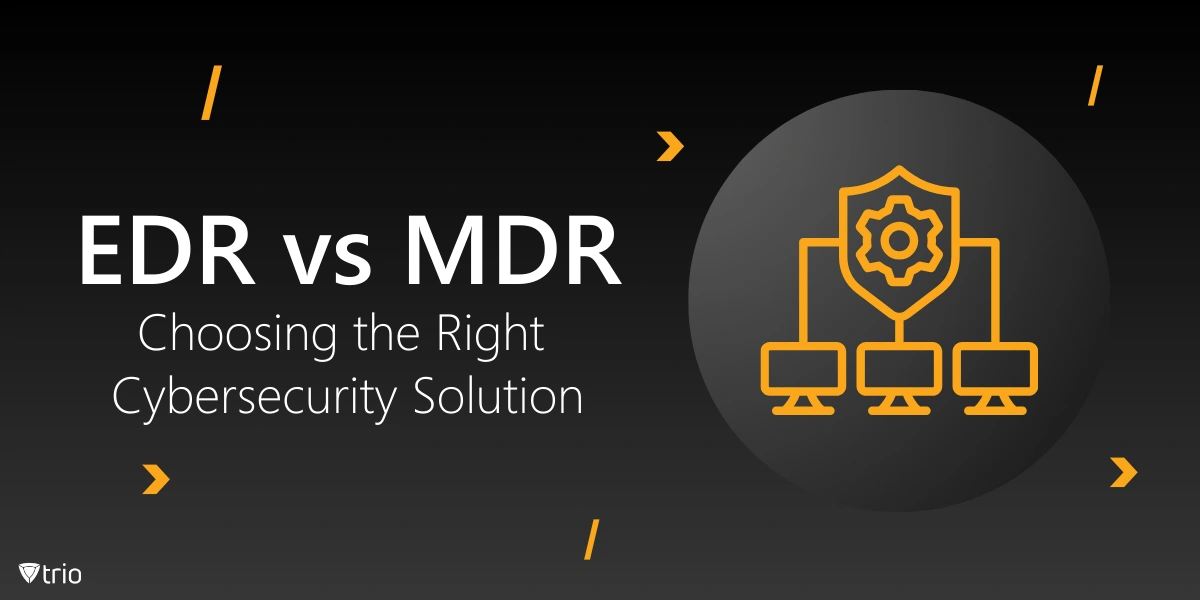In the ever-evolving world of cybersecurity, identifying the right solution for your organization is essential. This post will guide you through comparing endpoint detection and response (EDR) and managed detection and response (MDR), helping you determine which approach best aligns with your security needs.
At a high level, endpoint detection and response focuses on monitoring and protecting individual devices, while MDR is a fully managed service that provides broader, continuous threat detection and response. While EDR offers more control to organizations with in-house expertise, MDR provides 24/7 outsourced protection with expert-driven analysis.
In an environment where cyber threats are constantly evolving, prioritizing security is no longer optional. Whether you choose detection and response EDR or MDR, the decision impacts your ability to address threats effectively. Organizations must evaluate their internal capabilities, risk levels, and resources to select a solution that minimizes potential breaches and safeguards their digital assets.
EDR in Cybersecurity
EDR, short for Endpoint Detection and Response, is similar to having a vigilant security guard stationed at every device in your network. It continuously monitors endpoint activities, ready to detect and tackle potential threats. This means everything from laptops to smartphones is under the watchful eye of EDR tools, ensuring timely responses whenever anomalies arise.
EDR tools are equipped with real-time monitoring, automated threat detection, and response mechanisms. It fosters a system that not only identifies suspicious behavior but also triggers automated processes to mitigate risk—all within seconds. This strategic approach gives SME IT security teams a leg up in managing risks efficiently without requiring massive resources.
EDR is particularly useful for organizations with dedicated in-house security teams. For businesses with IT security setups, EDR tools offer reliable protection without overwhelming resources. EDR benefits include enhanced visibility and quicker response times, perfect for managing sophisticated threats that may otherwise slip through traditional defenses.
MDR in Cybersecurity
MDR, or Managed Detection and Response, takes cybersecurity off your plate by providing a full-service solution. Instead of relying solely on in-house teams, MDR tools offer continuous monitoring and threat response managed by an external team of experts. It’s like having a 24/7 security force that steps in whenever suspicious activity is detected.
What sets the usage of MDR in cybersecurity apart is that it combines advanced MDR software with human expertise. Cyber threat management isn’t left to automated systems alone—there’s a dedicated team handling threat hunting, analysis, and incident response. This approach ensures that even sophisticated attacks don’t go unnoticed, reducing potential risks.
For organizations lacking the resources to support a full-time security team, MDR tools offer a transformative solution. They provide effective threat management for businesses looking to outsource these responsibilities, making it easier to maintain strong security without hiring expensive in-house specialists.

EDR vs MDR: Key Differences
Choosing between EDR and MDR depends on your organization’s needs and resources. While both solutions focus on threat detection and response, how they operate and who manages them are where the real differences lie. Let’s break down what separates these two approaches.
Comparison of Capabilities
EDR is all about automation and self-management, ideal for organizations with in-house teams. On the other hand, detection and response MDR solutions involve a Security Operations Center (SOC) staffed by experts who manage everything for you. The level of human intervention in MDR ensures more comprehensive coverage.
Responsibility and Control
With the help of EDR providers, you’re in control—everything is handled internally. However, if you want to offload the heavy lifting, MDR offers a fully managed service where external experts take charge. This is particularly useful for organizations lacking the resources to implement a robust cybersecurity incident response plan on their own.
Cost and Scalability
EDR typically has lower upfront costs but requires a skilled team to manage it, making it suitable for smaller businesses. In contrast, MDR scales better for enterprises with complex needs. The investment in detection and response MDR solutions covers ongoing monitoring and expert analysis, ensuring comprehensive protection without requiring internal resources.
Choosing the Right Solution
Now that we’ve explored the core differences between EDR and MDR, how do you decide which one fits your organization’s unique needs? The key lies in understanding your current resources, risk appetite, and what level of control you require.
Start by assessing your internal capabilities. Do you have an experienced IT team or rely on external support? Understanding your risk exposure and budget will guide your decision. Organizations that need tight control over their operations may lean towards EDR, while those prioritizing 24/7 coverage should consider extended detection and response services like MDR.
EDR is a solid choice for companies with in-house expertise who want to manage their cybersecurity hands-on. If your team excels at behavior analysis and real-time threat management, EDR offers the flexibility to fine-tune defenses. It’s also effective for meeting certain types of compliance that require detailed control over incident response.
For businesses without dedicated cybersecurity experts, MDR is often the smarter route. With MDR, you get 24/7 support, including continuous monitoring and response. This is crucial for organizations that lack the bandwidth to stay on top of threats or need to handle complex requirements without a full security team.
Cyber Liability Insurance
Did you know that having robust EDR or MDR solutions can make your business more attractive to cybersecurity insurance providers? Insurers often view companies with advanced detection systems as lower risks, which can lead to better coverage options or reduced premiums. Strong defenses signal your commitment to minimizing incidents.
In many cases, cybersecurity insurance providers require companies to have specific protections in place. Whether it’s EDR tools that quickly address a false positive or MDR services that offer 24/7 threat monitoring, meeting these criteria is key to qualifying for coverage. Some insurers even insist on managed services to lower liability.
Cyber liability insurance can help with everything from legal fees to data breach recovery. It’s a safety net, but pairing it with effective EDR or MDR solutions ensures comprehensive coverage. The combination of cybersecurity measures and tailored insurance coverage creates a solid defense against evolving threats.
Industry Trends and the Future of EDR and MDR
AI and machine learning are rapidly transforming how EDR and MDR tools operate. Security professionals are leveraging these technologies for behavior analysis, automating responses, and predicting threats before they strike. AI now plays a significant role in monitoring user activity, and many organizations are already integrating AI for cybersecurity operations. As these capabilities grow, expect even faster detection and more accurate responses across EDR and MDR platforms.
As cyberattacks become more sophisticated, EDR and MDR tools must evolve. New threats like AI-driven ransomware and deepfake attacks require security solutions that extend beyond traditional methods. Solutions incorporating extended detection and response (XDR) strategies are becoming more common, offering broader visibility across diverse environments and adapting to complex threat landscapes.
The complexity of cybersecurity has driven a surge in managed services like MDR. As organizations face skills shortages—92% report gaps in key areas such as AI and cloud security according to Field Effect—outsourcing is often the most efficient path forward. The need for robust information and event management systems will continue to rise, as businesses prioritize streamlined, comprehensive cybersecurity approaches.
Integrating EDR and MDR With Mobile Device Management
As mobile devices become an integral part of workplace operations, the need for robust cybersecurity measures is crucial. EDR and MDR solutions can integrate seamlessly with Mobile Device Management (MDM) systems, extending continuous monitoring and data collection to mobile devices. This ensures that all endpoints are secured under one comprehensive strategy.
With remote work on the rise, mobile devices have become prime targets for cyber threats. The convenience of mobile access is undeniable, but it brings risks that traditional endpoint security might miss. Combining EDR and MDR with MDM addresses these challenges by covering gaps in mobile-specific threats like malicious apps and phishing attacks.
When integrated with EDR or MDR, MDM enhances security by enforcing policies and monitoring device behavior. From app usage restrictions to real-time threat detection, this synergy allows for more active management and threat mitigation across mobile devices. Continuous monitoring of mobile endpoints ensures your organization stays protected against emerging vulnerabilities.
Our product, Trio, offers a unique solution that combines MDM with endpoint and managed detection tools, providing holistic protection for your organization’s entire digital landscape. Interested in experiencing this integration firsthand? Check out our free demo and explore how smoothly our solutions work to secure every device.

Wrapping It Up: EDR vs. MDR
So, what’s the bottom line? Endpoint Detection and Response (EDR) solutions focus on identifying threats at a device level, while Managed Detection and Response (MDR) goes beyond by offering 24/7 monitoring, threat hunting, and expert intervention. When combined with mobile device management (MDM), you get robust protection that covers every layer of your security needs. Integrating these approaches is essential to staying ahead in today’s cybersecurity landscape.
Choosing between EDR and MDR depends on your organization’s resources, risk profile, and existing security setup. Are you ready to explore which solution best fits your needs.
Know about news
in your inbox
Our newsletter is the perfect way to stay informed about the latest updates,
features, and news related to our mobile device management software.
Subscribe today to stay in the know and get the most out of your mobile
devices with our MDM solution app.
Recent Posts

Erase the Risk: Protect with Zero Standing Privileges
Learn how zero standing privileges eliminate persistent access rights, enhance data security and reduce the risk of unauthorized access.

Understanding Access Control Types in Cybersecurity w/ Examples
Thorough understanding of access control types & the knowledge to make informed decisions about implementing security measures in your organization.

Cloud Data Protection: Safeguarding Information in the Cloud
Learn essential strategies for robust cloud data protection, exploring tools, best practices, and policies that safeguard sensitive information.





